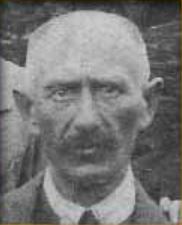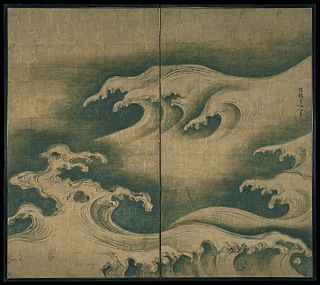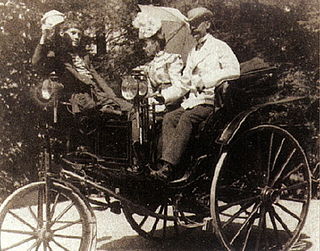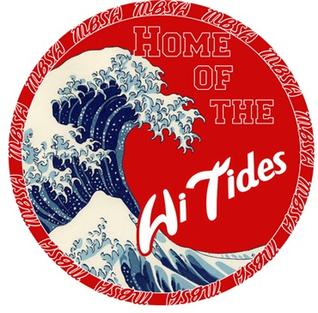 W
WMarine art or maritime art is a form of figurative art that portrays or draws its main inspiration from the sea. Maritime painting is a genre that depicts ships and the sea—a genre particularly strong from the 17th to 19th centuries. In practice the term often covers art showing shipping on rivers and estuaries, beach scenes and all art showing boats, without any rigid distinction - for practical reasons subjects that can be drawn or painted from dry land in fact feature strongly in the genre. Strictly speaking "maritime art" should always include some element of human seafaring, whereas "marine art" would also include pure seascapes with no human element, though this distinction may not be observed in practice.
 W
WApproaching Thunder Storm is an 1859 painting by American painter Martin Johnson Heade. It was his largest painting to date. The painting is in the collection of the Metropolitan Museum of Art. It is praised for its dramatic depiction of the threatening mood of blackening skies and eerily illuminated terrain prior to the storm itself. The painting has been connected to mounting tensions before the Civil War, which were often expressed in terms of natural imagery.
 W
WMarine art was especially popular in Britain during the Romantic Era, and taken up readily by British artists in part because of England's geographical form. This article deals with marine art as a specialized genre practised by artists who did little or nothing else, and does not cover the marine works of the leading painters of the period, such as, and above all, J.M.W. Turner. The tradition of British marine art as a specialized genre with a strong emphasis on the shipping depicted began in large part with the artists Willem Van de Velde the Elder and his son, called the Younger in the early 18th century. The Van Veldes, originally from Holland, moved to England to work for King Charles II). By the 17th century, marine art was commissioned mostly by merchant seamen and naval officers and created by marine art specialists. In part, marine art served as a visual portrayal of Britain's power on the sea and as a way of historically documenting battles and the like. As British sea captains began to recognize the ability of marine artists to bring Britain's success on the sea to the public on land, some took on an active role in supporting this type of artwork. For example, marine artist Robert Cleveley was hired by Captain William Locker to work in HMS Thames as a clerk, and Captain Locker, interested in employing artists, is believed to have played a significant role in encouraging Cleveley to work as a marine painter. Captains would act as marine artists' patrons, commissioning them to paint portraits of themselves and pictures depicting important battles. A few significant marine artists who were supported in this way by naval officers are Nicholas Pocock, Thomas Luny, and George Chambers. William Hodges, for example, who was trained to draw at William Shipley's Academy, was hired by the Admiralty to finish his pictures from Cook's 1772 voyage for publication upon reaching home in 1775. Captains also commissioned artists to paint portraits of their ships.
 W
WThe Burghley Nef is a silver-gilt salt cellar made in Paris in 1527–28. In medieval France the word nef was applied to various types of boat-shaped containers, including the most magnificent objects intended for the dining tables and buffets of the rich. Apart from having an obvious ornamental quality, their function was to hold personal pieces of cutlery or, as in this case, salt or spices—there is a detachable compartment on the rear deck, which was presumably passed around the table. This nautilus shell, mounted in silver, was a rare natural curiosity.
 W
WGhost Ship is an outdoor 2001 sculpture by James Harrison and Rigga, a group of local artists, located along the Eastbank Esplanade in Portland, Oregon. It is made of copper, stainless steel, art glass, and two lamps. It is part of the City of Portland and Multnomah County Public Art Collection courtesy of the Regional Arts & Culture Council.
 W
WGoddess of the Sea is a sculpture by Kristen Visbal, installed in Plyler Park, Myrtle Beach, South Carolina, United States on April 18, 2018. The bronze sculpture depicts a mermaid and two dolphins in water.
 W
WThe Great Wave off Kanagawa , also known as The Great Wave otherwise known as, The Wave, is a woodblock print by the Japanese ukiyo-e artist Hokusai. It was published sometime between 1829 and 1833 in the late Edo period as the first print in Hokusai's series Thirty-six Views of Mount Fuji. The image depicts an enormous wave threatening three boats off the coast in the Sagami Bay while Mount Fuji rises in the background. Sometimes assumed to be a tsunami, the wave is more likely to be a large rogue wave.
 W
WA half hull model ship is a wooden model ship featuring only one half of a boat's hull without rigging or other fixtures.
 W
WAdolf Kaufmann was an Austrian landscape and marine artist.
 W
WKing Neptune is a large bronze statue located in Virginia Beach, Virginia and sculpted by Paul DiPasquale. This statue stands at the front of Neptune park, and depicts the mythological god Neptune and is located at the entrance of Neptune Park on the Virginia Beach Boardwalk at 31st Street. This sculpture weighs 12 tons and is listed as 24 feet (7.3 m) or 34 feet (10 m) tall. It was built and opened in 2005. The design consists of a 12-foot tall rock base surrounded by various fish, dolphins, lobsters, and octopuses. Above this base, the figure of Neptune begins, starting with his waist. Neptune holds a trident in his right hand and rests his left hand on a loggerhead turtle.
 W
WJan Theodoor Kruseman was a Dutch painter who specialized in landscapes and maritime scenes.
 W
WMonument of Sailor is a monument in Szczecin, Poland at the Grunwald Square at the John Paul II Avenue. It was designed by Ryszard Chachulski and completed on 19 June 1980.
 W
WThe monument to the sailors of the ship "Guba" – is a monument to the sailors who died as a result of the ship "Guba" sinking, which was conducting research in the Caspian Sea, at Cape Shuvelan on 14 September 1857. As a result of the crash, 22 crew members died, 57 people were rescued. After this tragedy, in order to ensure the safety of ships, the construction of lighthouses on Absheron began. The author of the monument's project, erected in 1889 in Shuvalan, was the architect Johann Edel.
 W
WNautilus is a black-and-white photograph taken by Edward Weston in 1927 of a single nautilus shell standing on its end against a dark background. It has been called "one of the most famous photographs ever made" and "a benchmark of modernism in the history of photography."
 W
WA nef is an extravagant table ornament and container used in the Middle Ages and Renaissance, made of precious metals in the shape of a ship – nef was another word for a carrack in French. If not just used for decoration, it could hold salt or spices, or cutlery, or even napkins. The large nef depicted in the well-known calendar miniature for January from the Très Riches Heures du Duc de Berry is being used to hold, and perhaps wash, gilt dishes from the table service.
 W
WThe Palestrina Mosaic or Nile mosaic of Palestrina is a late Hellenistic floor mosaic depicting the Nile in its passage from the Blue Nile to the Mediterranean. The mosaic was part of a Classical sanctuary-grotto in Palestrina, a town east of Ancient Rome, in central Italy. It has a width of 5.85 metres and a height of 4.31 metres and provides a glimpse into the Roman fascination with ancient Egyptian exoticism in the 1st century BC, both as an early manifestation of the role of Egypt in the Roman imagination and an example of the genre of "Nilotic landscape", with a long iconographic history in Egypt and the Aegean.
 W
WPeintre de la Marine is a title awarded by the minister of defence in France to artists who have devoted their talents to the sea, the French Navy and other maritime subjects. It was set up in 1830 by the July Monarchy and can be awarded to painters, photographers, illustrators, engravers, and sculptors.
 W
WRough Waves is a painting by the Japanese artist Ogata Kōrin, on a two-panel byōbu. The work was created c. 1704 – c. 1709, and depicts a swirl of stormy sea waves. It has been in the collection of the Metropolitan Museum of Art, New York, since 1926, when it was acquired with financial support from the Fletcher Fund.
 W
WEugeniu Voinescu was a Romanian diplomat and painter, who specialized in maritime scenes.
 W
WGeorge Webster was a 19th-century British Marine Art painter. He toured extensively and painted seascapes of the places he visited. His work was exhibited at the Royal Society of British Artists and the Royal Academy.
 W
WEugen Zardetti was a Swiss portrait and marine painter. He was also an early automobile owner.
 W
W